|
A cattle drive by Smithfield Market
A day in St John Street, City of London, 19th June 2004
Smithfield market is one of London's oldest markets, where meat has been bought and sold for over 800 years. A livestock market occupied the site as early as the 10th century.
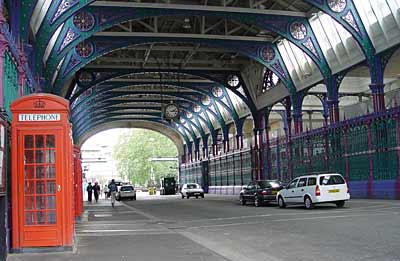
View inside Smithfield Meat market
In 1860 the Corporation of London obtained an act of parliament to construct new buildings on the Smithfield site, with work starting in 1866.
Designed by City Architect Sir Horace Jones, the buildings were completed in November 1868 at a cost of �993,816.
The two main sections of of the market, the East and West Buildings, were built above railway lines which enabled meat to be delivered directly to the market.
A Poultry Market opened in 1875, although this building was subsequently destroyed by a major fire in 1958, being replaced by a rather inappropriate building in 1962.
The General Market was added in 1883 with the Annexe Market following in 1888.
Recent modernisation has seen 44 hygenic, temperature controlled stalls replacing the original 162 stalls inside the East and West Buildings, with some parts of the building being used as office space.

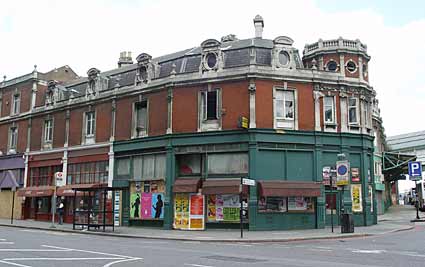
General Market buildings threatened with demolition, Smithfield, London
The future isn't entirely secure for the market. There are strong rumours than the Meat Market may end up being relocated out of London when tenants' leases expire in ten years.
More pressing is the threat of demolition hanging over the General Market buildings at the westernmost end of the market complex, fronting Farringdon Road and Snow Hill.
The General Market buildings comprise three blocks - the General Market, the Annex (formerly the fish market), both by Horace Jones, which is joined to the 'Red House' (a cold store) and finally the diminutive lavatory block, possible also by Jones.
Save Britain's Heritage are concerned for their future, and their website makes a strong case for preservation:
"These buildings are high quality buildings by a pre-eminent Victorian architect. They are key buildings in the Smithfield conservation area and should be listed.
They form a part of enclave of historic buildings unlike any other in the City, retaining a powerful historic and architectural sense of place. They are capable of reuse with minimal intervention, and are potentially a huge asset to this part of the City, yet they lie purposely disused and without maintenance."

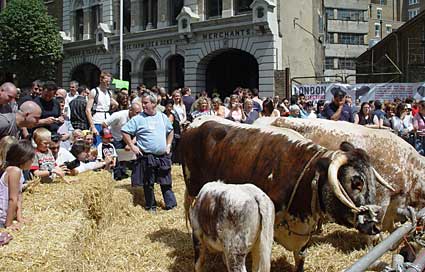
Cattle in St John Street, London.
On 19th June 2004, a street event was put on by a local architects firm promising a 'Cattle drive and family picnic' with
St John Street being closed to traffic, and cows driven from their traditional holding pen down to Smithfield.'
Now, I admit, I had visions of teams of rodeo style riders a-whip-crackin' away as great herds of prime beef came thundering through the narrow streets of London, but this was rather a sedate affair.
As you can see the 'cattle drive' numbered no more than five bulls, a far cry from the huge herds that use to be driven from City Road along St John Street to Smithfield Market.

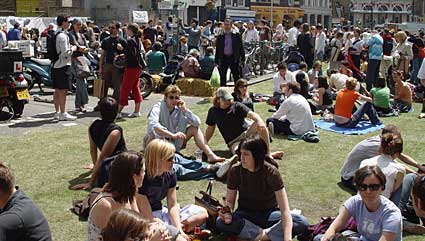
People relax on the grassy lawn created on St John Street.
A large chunk of the lower part of St John Street (by Smithfield Market) was grassed over, with local cafes and shops serving food and drink (perhaps they got the idea from the Mayday 2000 protests?)
This chilled-out scene is a world away the hellish vision of Smithfield described by Charles Dickens in Oliver Twist (1838):
'It was market morning. The ground was covered nearly ankle deep with filth and mire; and a thick steam perpetually rising from the reeking bodies of the cattle, and mingling with the fog, which seemed to rest upon the chimney tops, hung heavily above ...
Countrymen, butchers, drovers, hawkers, boys , thieves, idlers, and vagabonds of every low grade, were mingled together in a dense mass: the whistling of drovers, the barking of dogs, the bellowing and plunging of beasts, the bleating of sheep, and the grunting and squealing of pigs; the cries of hawkers, the shouts, oaths, and quarrelling on all sides, the ringing of bells, and the roar of voices that issued from every public house; the crowding, pushing, driving, beating, whooping and yelling; the hideous and discordant din that resounded from every corner of the market; and the unwashed, unshaven, squalid, and dirty figures constantly running to and fro, and bursting in and out of the throng, rendered it a stunning and bewildering scene which quite confused the senses.'

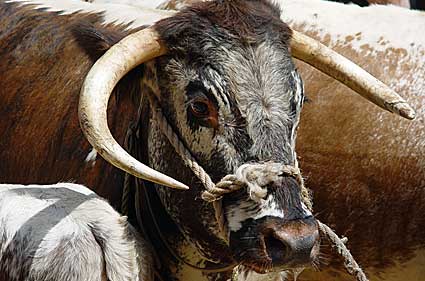
Large bull in St John Street, Smithfield, London
Although this bull seems happy enough, it was a different scene in the 19th century when many a writer was obliged to comment on the chaos and cruelty that took place around Smithfield Market.
Here, Dr Andrew Wynter ('The London Commissariat') writes in the Quarterly Review of 1854:
If the stranger can make his way through the crowd ... and can manage to raise himself a few feet above the general level, he sees before him in one direction, by the dim light of hundreds of torches, a writhing party-coloured mass, surmounted by twisting horns, some in rows, tied to rails which run along the whole length of the open space, some gathered in one struggling knot.
In another quarter, the moving torches reveal to him, now and then, through the misty light, a couple of acres of living wool, or roods of pigs� skins. If he ventures into this closely wedged and labouring mass, he is enabled to watch more narrowly the reason of the universal ferment among the beasts.
The drover with his goad is forcing the cattle into the smallest possible compass, and a little further on half a dozen men are making desperate efforts to drag refractory oxen up to the rails with ropes ...
The sheep, squeezed into hurdles like figs into a drum, lie down upon each other, �and make no sign�; the pigs, on the other hand, cry out before they are hurt.
This scene, which has more the appearance of a hideous nightmare than a weekly exhibition in a civilized country, is accompanied by the barking of dogs, the bellowing of cattle, the cursing of men, and the dull blow of sticks ... The hubbub generally abates from 12 o�clock at night, the time of opening, to its close at 3 p.m. the next day, although during the whole period as fresh lots are �headed up�, individual acts of cruelty continue...
Many of the drovers we doubt not are ruffians, but we believe the greater part of the cruelty is to be ascribed to the market�place itself which, considering the immense amount of business to be got through on Mondays and Fridays, is absurdly and disgracefully confined...

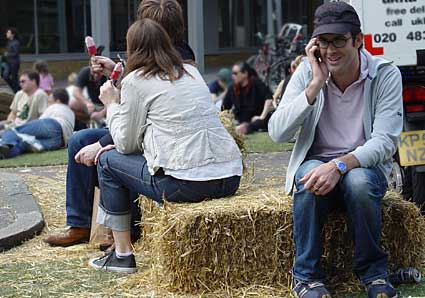
Chilling in St John Street
Happily, the 'cattle drive' was a far more civilised event, with the fine weather drumming up ample business for an Ice Cream Van parked nearby.
Hay bales were conveniently scattered around the road, providing a handy platform for making calls and eating lollies!
A large exhibition took place in the nearby old Farmiloe buildings on 34�36, St John Street, which gave me an opportunity to revisit the unhappy scene of My Office Job Hell!
RELATED INFO:
Sheep drive to Smithfield Market, London Biennale, 2006
Save Smithfield Market!
Smithfield market 2009
|